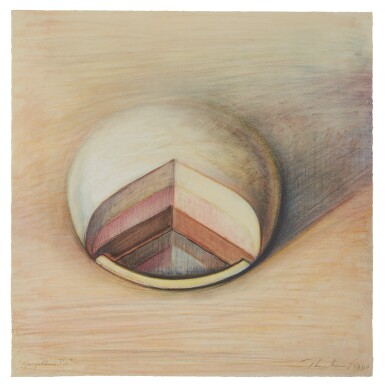A Life of Discovery: Works from The Allan Stone Collection | Contemporary Art Online
A Life of Discovery: Works from The Allan Stone Collection | Contemporary Art Online

WAYNE THIEBAUD | NEAPOLITAN PIE
Lot Closed
December 10, 05:26 PM GMT
Estimate
150,000 - 200,000 USD
Lot Details
Description
WAYNE THIEBAUD
b.1920
NEAPOLITAN PIE
signed, titled and dated 1990
pastel and charcoal on lithograph
Sheet: 18½ by 18½ in. (47 by 47 cm)
Framed: 29 by 28 in. (73.7 by 71.1 cm)
Please note that this work will be exhibited at Sotheby’s. Purchased items will be available for collection at Crozier Fine Arts, 1 Star Ledger Plaza, Newark, NJ as of Thursday, December 13th.
Executed in 1990. This work is a unique hand-colored proof aside from a larger edition.
In an attitude similar to artists such as Degas, Gaugin and Munch, Wayne Thiebaud often sees the discarded trial proof "as the beginning point of experimentation with the use of hand coloring" (Bill Berkson, et. al. Vision and Revision: Hand Colored Prints by Wayne Thiebaud. San Francisco 1991, p. 99). A trial proof by definition is a kind of experiment in the development of a print edition, and so focuses the artist's eye on possibilities and directions for development. For Thiebaud, "it is this potential for change that captivates me" (ibid., p. 11). In Neapolitan Pie, 1990, Thiebaud has enhanced a lithograph with pastel and charcoal, lending the same subtlety, nuance of light and shadow, changing moods of color, and aura as he lends to his paintings and directly drawn works on paper. As Bill Berkson states in Vision and Revision: Hand Colored Prints by Wayne Thiebaud, “taking a discarded or trial proof of a print one step further by adding colors and adjusting details is more than a matter of mere touching up or busy work: the modified object elaborates upon a set theme and reveals aspects that previously might have been omitted” (ibid., p. 94). As Thiebaud elaborates he also illuminates, inviting us to be fully in touch with a reality more vivid than what we take for granted. Thiebaud makes us look, and look again, to see “with new eyes that which we thought we knew (ibid., p. 100).
Wayne Thiebaud has made the mass-produced foods and objects- excess and uniformity specific to postwar America-into a unique exploration of color, shadow and form. In his own words, “common objects become strangely uncommon when removed from their context and ordinary ways of being seen” (Gene Cooper, Wayne Thiebaud: Survey of Painting 1950-1972, Long Beach 1972, n.p..). Thiebaud often places his still life subjects on a white or near white background in order to eliminate the effects that an environment might have on an object’s true colors. In addition, he invests great detail and highly specific color in the shadows that his still life subjects cast, intensifying the presence of the objects in space. In Neapolitan Pie, the pie layers, revealed by the removal of a generous slice, are bathed in shadow and light, the refined precision of their edges in counterpoint to the looser background. Ultimately, Thiebaud’s still lifes “radiate a peculiar emotion that we have sensed before in such lovely areas of American paint as those fruit bowls in Hopper’s restaurant or the children’s building blocks in Eakins—a note of yearning, a melancholy undercurrent of aspiration implanted even in things of pleasure that we recognize more easily than understand” (Steven A. Nash and Adam Gopnik, Wayne Thiebaud: A Paintings Retrospective, New York 2000, p. 40)
Wayne Thiebaud was born in 1920 in Mesa, Arizona. From 1938-1949 he was a cartoonist and designer in California and New York. He also served as an artist in the First Motion Picture Unit of the United States Army Air Forces from 1942-1945. Thiebaud attended San Jose State College (now San Jose State University) followed by Sacramento State College (now California State University, Sacramento), where he received his BA in 1951 and his MA in 1952. For over fifty years, Thiebaud has been a fixture of American Art, the recipient of numerous awards, with highlights including the 1994 National Medal of Arts, given by the then President Clinton, a 2001 Lifetime Achievement Award from the American Academy of Design, and a 2007 Bay Area Treasure Award from the San Francisco Museum of Modern Art. Thiebaud has been honored with gallery and museum exhibitions almost every year since 1960, highlighted by a 1985 retrospective at the San Francisco Museum of Modern Art and a 2001 retrospective that traveled from the de Young Fine Arts Museum of San Francisco, to the Modern Art Museum of Fort Worth, the Phillips Collection in Washington D.C., and the Whitney Museum of American Art. Allan Stone began representing Wayne Thiebaud in 1962, just as he began to develop his most admired themes. Over the years he rose from relative obscurity as a miscategorized California Pop artist to one of the most celebrated painters of the twentieth century. Thiebaud lives and works in Sacramento, California.
